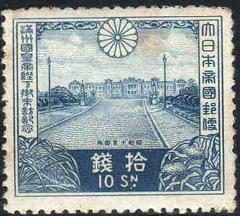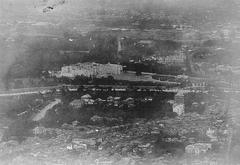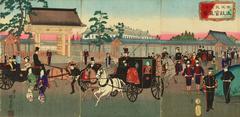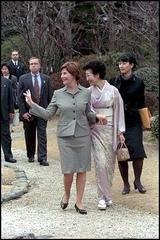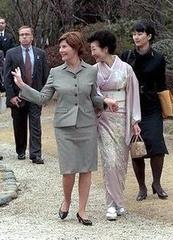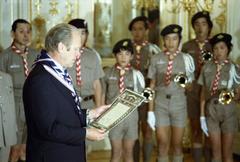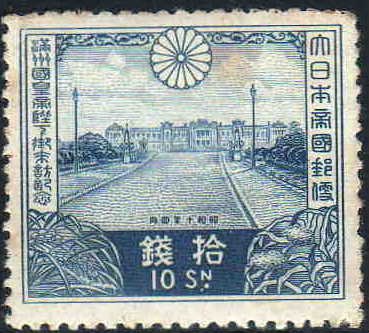
Akasaka Palace: Visiting Hours, Tickets, and Your Complete Guide to Tokyo’s Historical Site
Date: 14/06/2025
Introduction
Akasaka Palace, officially known as the State Guest House (Geihinkan), is a remarkable symbol of Japan’s transformation during the Meiji era and its ongoing role in international diplomacy. Located in central Tokyo, this Neo-Baroque palace astonishes visitors with its grand European-inspired architecture, while subtle Japanese motifs remind guests of the nation’s deep cultural roots. Recognized as a National Treasure, Akasaka Palace stands as a testament to Japan’s modernization, blending Western opulence with Japanese tradition. This guide provides everything you need to plan your visit—covering historical context, architectural highlights, visiting hours, ticketing, accessibility, nearby attractions, and practical travel tips.
For the latest updates and more details, refer to the official resources: (Geihinkan Official Site), (Japan City Tour), (Go Tokyo).
Table of Contents
- History and Significance
- Visitor Information
- Highlights of Akasaka Palace
- Nearby Attractions
- Frequently Asked Questions (FAQs)
- Conclusion and Planning Tips
- References
History and Significance
Origins and Construction
The land now housing Akasaka Palace was once part of the Kishū Domain during the Tokugawa shogunate and later transferred to the Imperial Household after the Meiji Restoration (Wikipedia). Construction began in 1899 and was completed in 1909 as the Tōgū Gosho (Crown Prince’s Palace) for the future Emperor Taisho. The design, entrusted to Katayama Tokuma—a protégé of British architect Josiah Conder—reflected Japan’s drive to modernize by adopting Western architectural forms (Geihinkan Official Site; Japan City Tour).
Architectural Style and Symbolism
Akasaka Palace is the only Neo-Baroque Western-style palace in Japan, drawing inspiration from European landmarks such as the Palace of Versailles and the Hofburg Palace (Japan Experience). The grand white granite façade, Corinthian columns, balustrades, and mansard roof all echo 19th-century European opulence, while features like the chrysanthemum crest and statues of Japanese warriors reflect imperial heritage and national pride (JW Web Magazine).
Structural innovations included earthquake-resistant steel beams and thick granite-brick walls, showcased during the Great Kanto Earthquake of 1923 when the palace remained unharmed (Japan City Tour).
Evolution and Modern Use
After serving as the Crown Prince’s residence, the palace briefly became the Akasaka Detached Palace in 1914. During World War II and afterward, it housed various governmental offices. Recognizing its value, the Japanese government renovated the palace between 1968 and 1974, transforming it into the State Guest House. Since its reopening in 1974, Akasaka Palace has hosted global dignitaries and major summits, cementing its place in international diplomacy (Go Tokyo; Simple Travel and Recreation). In 2009, it became the first post-Meiji Restoration building designated a National Treasure (Japan Experience).
Visitor Information
Visiting Hours and Tickets
- General Opening Hours: Typically 10:00 AM – 5:00 PM (last admission: 4:30 PM). Closed Mondays (or the following day if Monday is a national holiday) and during official events. Some sources note opening as early as 9:30 AM on certain days—always check the official website for updates.
- Admission: Self-guided entry is generally free, but reservations are mandatory due to limited capacity. Guided tours (in English and Japanese) require advance booking and may carry a fee (starting at approximately ¥10,000 or $91.34 per person). Audio guides are available for a nominal fee.
- Booking: Tickets and reservations are available through the official Geihinkan website, with options for both self-guided and guided tours.
How to Get There
- By Train:
- Nagatacho Station (Tokyo Metro Hanzomon, Yurakucho, Namboku Lines) – about a 10-minute walk.
- Akasaka-mitsuke Station (Tokyo Metro Ginza, Marunouchi Lines) – about a 10-minute walk.
- Yotsuya Station (JR Chuo/Sobu, Tokyo Metro Marunouchi, Namboku Lines) – about a 7-minute walk.
- By Bus: Several city bus routes serve the Akasaka district. Check local schedules for specific routes.
Accessibility
Akasaka Palace is equipped for visitors with disabilities, including wheelchair ramps and elevators. Assistance can be arranged upon request; it is advisable to notify staff when booking. Audio guides and information panels are provided in multiple languages.
Guided Tours and Travel Tips
- Guided tours provide deep insights into the palace’s architecture, history, and cultural significance. Tours are available in English and Japanese, with limited spots—reserve early.
- Best seasons to visit: Spring (cherry blossoms) and autumn (foliage) for the most beautiful garden views.
- Photography: Permitted in gardens and some external areas; strictly prohibited inside the main building to protect the interiors.
- Dress code: Smart-casual attire is recommended. Comfortable shoes are advisable for extensive walking.
- Food and drink: Not allowed inside palace buildings or during tours.
Highlights of Akasaka Palace
Main Building and Interiors
- Grand Entrance Hall: Features a checkered floor of Italian marble and Japanese stone, with Corinthian columns and oil paintings by Koiso Ryohei (Japan City Tour).
- Hagoromo-no-Ma: Inspired by Versailles’ Hall of Mirrors, with chandeliers and a ceiling painting referencing the Japanese legend “Hagoromo.”
- Kacho-no-Ma: Used for banquets and ceremonies, decorated with intricate stucco and gilded moldings.
- Artistic Details: Stained glass, samurai motifs, chrysanthemum crests, and a blend of Western and Japanese artwork throughout.
Japanese Style Annex and Gardens
- Yushintei Pavilion: A traditional Japanese structure added in 1974, used for tea ceremonies and intimate state events. The annex embodies classic Japanese design and hospitality (Japan Guide).
- Gardens: Expansive French-style and Japanese gardens, featuring a grand fountain, seasonal floral displays, commemorative trees, and a tranquil pond. The gardens are especially photogenic in spring and autumn (Tokyo Park).
Nearby Attractions
- Tokyo Metropolitan Teien Art Museum: Showcases art deco architecture and cultural exhibitions.
- Hie Shrine: A serene Shinto shrine close to Akasaka Palace.
- Akasaka Sacas: A modern commercial complex with shopping and dining options.
- Imperial Palace East Gardens: Another historical site emphasizing Japan’s imperial history.
- 21_21 DESIGN SIGHT: Contemporary design museum in Roppongi.
Frequently Asked Questions (FAQs)
Q: What are Akasaka Palace’s visiting hours?
A: Usually 10:00 AM to 5:00 PM (last entry 4:30 PM); closed Mondays and during official events.
Q: Is an admission fee required?
A: Self-guided entry is free, but advance reservations are required. Guided tours have a fee.
Q: How do I reserve tickets?
A: Book online via the official Geihinkan website.
Q: Is the palace wheelchair accessible?
A: Yes, with ramps, elevators, and support services available.
Q: Are guided tours available?
A: Yes, in English and Japanese. Advance booking is highly recommended.
Q: Can I take photos inside the palace?
A: Photography is allowed in gardens and exterior areas only.
Q: Are children welcome?
A: Yes, all ages are welcome. Guides accommodate family groups.
Q: Are there special events at the palace?
A: Occasionally, official functions or exhibitions may limit public access. Always check the latest schedule.
Conclusion and Planning Tips
Akasaka Palace is a must-visit for those interested in architecture, history, or Japan’s role on the world stage. Its Neo-Baroque grandeur, combined with Japanese elegance, offers a unique window into the nation’s evolution and global presence. To make the most of your visit:
- Check official hours and closures before visiting.
- Reserve your tickets in advance, especially for guided tours.
- Plan extra time for security checks and to enjoy the gardens.
- Consider combining your visit with nearby historical sites for a richer Tokyo experience.
For comprehensive travel tips and audio tours, download the Audiala app, and stay updated via social media.
References
- Geihinkan Official Site
- Japan City Tour
- Go Tokyo
- JW Web Magazine
- Wikipedia
- Japan Guide
- Tokyo Park
- Simple Travel and Recreation
- Japan Experience
Images, virtual tours, and further visitor resources are available on the official Geihinkan website and linked sources. Relevant alt tags include “Akasaka Palace visiting hours,” “Akasaka Palace tickets,” and “Tokyo historical sites.”
